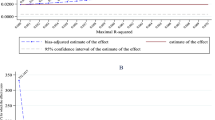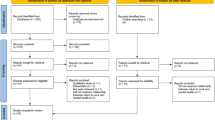Abstract
Objective
To investigate the relationship between maternal work and pregnancy outcome.
Methods
Over a 4-month period from October 2004 through February 2005, 2,419 women were interviewed shortly after delivery in the three main public and Health Insurance hospitals in Alexandria, Egypt. Of these, 730 (30.2%) were working and 1,689 (69.8%) were not working prior to delivery. A detailed description of working status was analyzed, along with a risk profile which was compared between the two groups.
Results
There was no significant association between different work characteristics and perinatal outcomes except for that between working posture, stress and delivery of smallfor-gestational-age (SGA) babies. There was an excess rate of SGA and perinatal death among the non-working group, while preterm delivery was significantly increased among those who worked throughout the whole pregnancy. After adjusting for confounders, the risk of preterm delivery was no longer significant (OR = 1.2, 95% CI = 0.96-1.7). On the other hand, working status had a beneficial effect on SGA and perinatal death (OR = 0.41, 95% CI = 0.26-0.64 and OR = 0.26, 95% CI = 0.14-0.48, respectively).
Conclusion
These results cast doubt on the risk of adverse pregnancy outcome for women who work during pregnancy. Work per se does not constitute a health risk factor and may even have a positive social impact on pregnancy. Further research on this topic in our region is recommended.
Résumé
Objectif
Étudier la relation entre le travail pendant la grossesse et les résultats périnatals.
Méthode
Nous avons interviewé 2 419 femmes peu de temps après leur accouchement dans les trois principaux hôpitaux publics et privés d’Alexandrie, en Égypte, sur une période de quatre mois. Parmi ces femmes parturientes, 730 (30,2 %) avaient travaillé et 1 689 (69,8 %) n’avaient pas travaillé pendant leur grossesse. Nous avons analysé des descriptions détaillées du travail effectué et comparé le profil de risques des deux groupes.
Résultats
Nous n’avons observé aucune association significative entre les diverses caractéristiques du travail et les résultats périnatals, exception faite d’un lien entre la posture au travail, la tension et l’accouchement d’un bébé petit pour son âge gestationnel (PAG). Les taux de PAG et de décès périnatal étaient plus élevés chez les femmes qui ne travaillaient pas, tandis que le taux d’accouchement prématuré augmentait considérablement chez les femmes ayant travaillé pendant toute la période de grossesse. En ajustant les taux pour tenir compte des facteurs de confusion, le risque d’accouchement prématuré n’était plus considérable (RC=1,2, IC de 95 % = 0,96-1,7). D’autre part, le fait de travailler avait un effet bénéfique sur les taux de PAG et de décès périnatal (RC=0,41, IC de 95 % = 0,26-0,64 et RC=0,26, IC de 95 % = 0,14-0,48, respectivement).
Conclusion
Ces résultats mettent en doute l’élément hasardeux du travail pendant la grossesse puisque le travail en soi ne constitue pas un facteur de risque pour la santé, mais peut même avoir un impact social positif sur la grossesse, ce qui suggère qu’il faudrait pousser les recherches sur ce sujet dans notre région.
Similar content being viewed by others
References
Henriksen TB, Hedegaard M, Secher NJ, Wilcox, AJ. Standing at work and preterm delivery. Br J Obstet Gynecol 1995;102(3):198–206.
Seguin, RE. Pregnancy and the working woman: A review. J Ark Med Soc 1998;95(3):115–18.
Chamberlain G. Effect of work during pregnancy. Obstet Gynecol 1985;65(5):747–50.
Berkowitz, GS. Employment-related physical activity and pregnancy outcome. J Am Med Womens Assoc 1995;50(5):167–69.
Eskenazi B, Fenster L, Wight S, English P, Windham GC, Swan, SH. Physical exertion as a risk factor for spontaneous abortion. Epidemiology 1994;5:6–13.
Hatch M, Ji B-T, Shu XO, Susser M. Do standing, lifting, climbing, or long hours have an effect on fetal growth? Epidemiology 1997;8:530–36.
Tan TC, Donnan SP, Chang, AM. Employment, physical overactivity and adverse pregnancy outcomes—applicability of AMA guidelines in Chinese women. Asia Pac J Public Health 1998;2:22–27.
Barnes DL, Adair LS, Popkin, BM. Women’s physical activity and pregnancy outcome: A longitudinal analysis from the Philippines. Int J Epidemiol 1999;20:162–72.
Ahlborg G. Physical work load and pregnancy outcome. J Occup Environ Med 1995;37:941–44.
Lin S, Gensburg L, Marshall EG, Roth GB, Dlugosz L. Effects of maternal work activity during pregnancy on infant malformations. J Occup Environ Med 1998;40:829–34.
Simpson, JL. Are physical activity and employment related to preterm birth and low birth weight? Am J Obstet Gynecol 1993;168:1231–38.
Lokey EA, Tran ZV, Wells CL, Myers BC, Tran, AC. Effects of physical exercise on pregnancy outcomes: A meta-analytic review. Med Sci Sports Exerc 1991;23:1234–39.
Irwin DE, Savitz DA, St Andre K, Hertz-Picciotto I. Study of occupational risk factors for pregnancy-induced hypertension among active duty enlisted Navy personnel. Am J Ind Med 1994;25:349–59.
Magann EF, Evans SF, Newnham, JP. Employment, exertion, and pregnancy outcome: Assessment by kilocalories expended each day. Am J Obstet Gynecol 1996;175:182–87.
Tafari N, Naeye RL, Gobezie A. Effects of maternal undernutrition and heavy physical work during pregnancy on birth weight. Br J Obstet Gynaecol 1980;87:222–26.
Clapp JF, Dichstein S. Endurance exercise and pregnancy outcome. Med Sci Sports Exerc 1994;16:556–62.
Tuntiserance P, Geater A, Chongsuvivatwong V, Kor-Anantakul O. The effect of heavy maternal workload on fetal growth retardation and preterm delivery. J Occup Environ Med 1998;40:1013–20.
Florack EIM, Zielhuis GA, Rolland R. The influence of occupational physical activity on the menstrual cycle and fecundability. Epidemiology 1994;5:14–18.
Central Agency for Public Mobilization and Statistics (CAPMAS), 2001. Economic participation of women in Egypt. Available online at: https://doi.org/www.aucegypt.edu/src/wsite1/Statistics/ Statistics2001.htm#Female/male%20gaps%20in %20basic%20indicators (Accessed August 1, 2005).
Egyptian human development report, 2004 (UNDP, Egypt). Available online at: http://www.aucegypt.edu/src/wsite1/index.htm (Accessed August 1, 2005).
Working Time Regulations 1998. SI 1998 No.1833 — Health Aspects. Available online at: http://www.occhealth.co.uk/Working_time_regs. htm (Accessed March 1, 2005).
Elo, AL. Assessment of mental stress factors at work. In: Zenz C, Occupational Medicine, Third edition. St. Louis, MO: Mosby, 1994;945–55.
Ballard JL, Khoury JC, Wedig K, Wang L, Eilers-Walsman BL, Lipp R. New Ballard score expanded to include extremely premature infants. J Pediatrics 1991;119(3):417–23.
Spinillo A, Capuzzo E, Baltaro F, Piazza G, Nicola S, Iasci A. The effect of work activity in pregnancy on the risk of fetal growth retardation. Acta Obstet Gynecol Scand 1996;75(6):531–36.
Escriba-Aguir V, Perez-Hoyos S, Saurel-Cubizolles, MJ. Physical load and psychological demand at work during pregnancy and preterm births. Int Arch Occup Environ Health 2001;74(8):583–88.
Henriksen TB, Hedegaard M, Secher, NJ. The relation between psychosocial job strain and preterm delivery and low birthweight for gestational age. Int J Epidemiol 1994;23(4):764–74.
Hanke W, Kalinka J, Makowiec-Daboowska T, Sobala W. Heavy physical work during pregnancy — a risk factor for small-for-gestational-age babies in Poland. Am J Ind Med 1999;36(1):200–5.
Zhu JL, Hjollund NH, Olsen J. National Birth Cohort in Demark. Shift work, duration of pregnancy and birth weight: The National Birth Cohort in Denmark. Am J Obstet Gynecol 2004;191(1):285–91.
Brett KM, Strogatz DS, Savitz, DA. Employment, job strain, and preterm delivery among women in North Carolina. Am J Public Health 1997;87(2):199–204.
Henriksen TB, Hedegaard M, Secher, NJ. Standing and walking at work and birthweight. Acta Obstet Gynecol Scand 1995;74(7):509–16.
Ceron-Mireles P, Harlow SD, Sanchez-Carrillo, CI. The risk of prematurity and small for gestational age births in Mexico City: The effect of working conditions and antenatal leave. Am J Public Health 1996;86(6):825–31.
Mozurkewich EL, Luke B, Avni M, Wolf, FM. Working conditions and adverse pregnancy outcome: A meta analysis. Obstet Gynecol 2000;95(4):623–35.
Gazit-Nissim S, Sheiner E, Mazor M, Shoham-Vardi I. Examining the connection between physical exertion in pregnancy and premature birth. Harefauh 2000;138(60):444–48.
Hanke W, Saurel-Cubizolles MJ, Sobala W, Kalinka J. Employment status of pregnant women in Central Poland and the risk of preterm delivery and small-for-gestational-age infants. Eur J Public Health 2001;11(1):23–28.
Pompeii LA, Savitz DA, Evenson KR, Rogers B, Macmahon M. Physical exertion at work and the risk of preterm delivery and small-for-gestationalage birth. Obstet Gynecol 2005;106(6):1279–88.
Sydsjo A, Brynhildsen J, Selling KE, Josefsson A, Sydsjo E. Influence of rest during pregnancy on birth weight in working women. Obstet Gynecol 2006;107(5):991–96.
Saurel-Cubizolles MJ, Zeitlin J, Lelong N, Papiernik E, Di Renzo GC, Breart G, et al. Employment, working conditions, and preterm birth: Results from the European Case Control Survey. J Epidemiol Community Health 2004;58(5):395–401.
Henriksen TB, Savitz DA, Hedegaard M, Secher, NJ. Employment during pregnancy in relation to risk factors and pregnancy outcome. Br J Obstet Gynecol 1994;101(10):858–65.
Saurel-Cubizolles MJ, Subtil D, Kaminski M. Is preterm delivery still related to physical working condition during pregnancy? J Epidemiol Community Health 1991;45(1):29–34.
Mabury MC, Linn S, Monson RR, Wegman DH, Schoenbaum SC, Stubblefield PG, et al. Work and pregnancy. J Occup Med 1984;26(6):415–21.
Murphy JF, Dauncey M, Newcombe R, Garcia J, Elbourne D. Employment in pregnancy: Prevalence, maternal characteristics, and perinatal outcome. Lancet 1984;1(8387):1163–66.
Hanke W, Kalinka J, Szymczak W. Socialoccupational risk factors for fetal growth retardation and preterm birth. Role of occupational and non-occupational work. Med Prev 1995;46(5):433–42.
Author information
Authors and Affiliations
Corresponding author
Rights and permissions
About this article
Cite this article
Arafa, M.A., Amine, T. & Abdel Fattah, M. Association of Maternal Work with Adverse Perinatal Outcome. Can J Public Health 98, 217–221 (2007). https://doi.org/10.1007/BF03403716
Received:
Accepted:
Published:
Issue Date:
DOI: https://doi.org/10.1007/BF03403716




